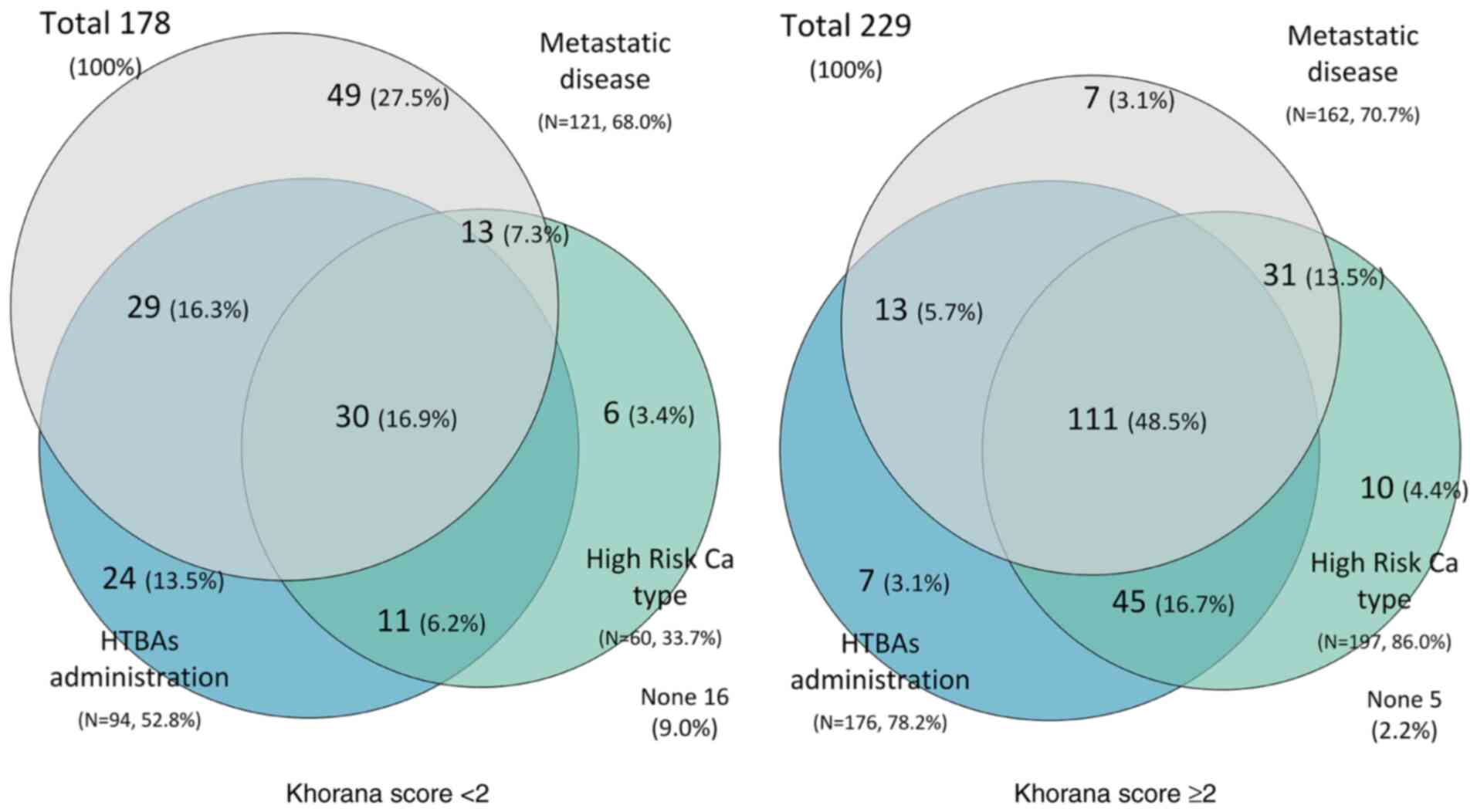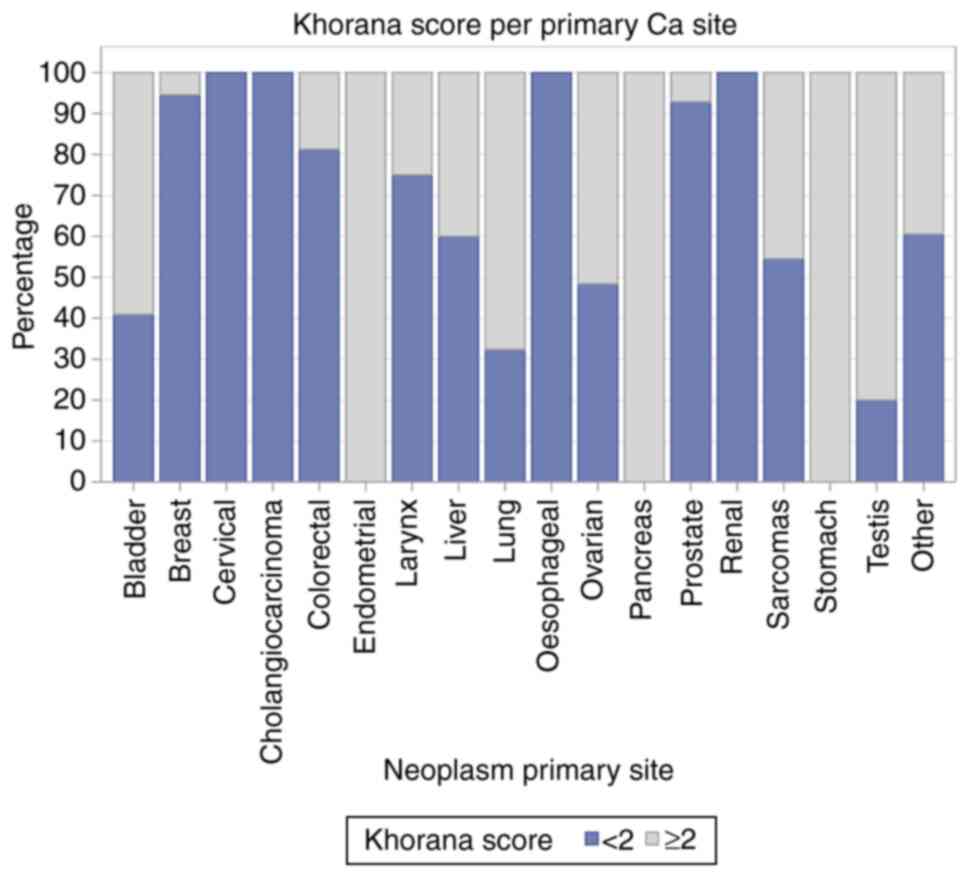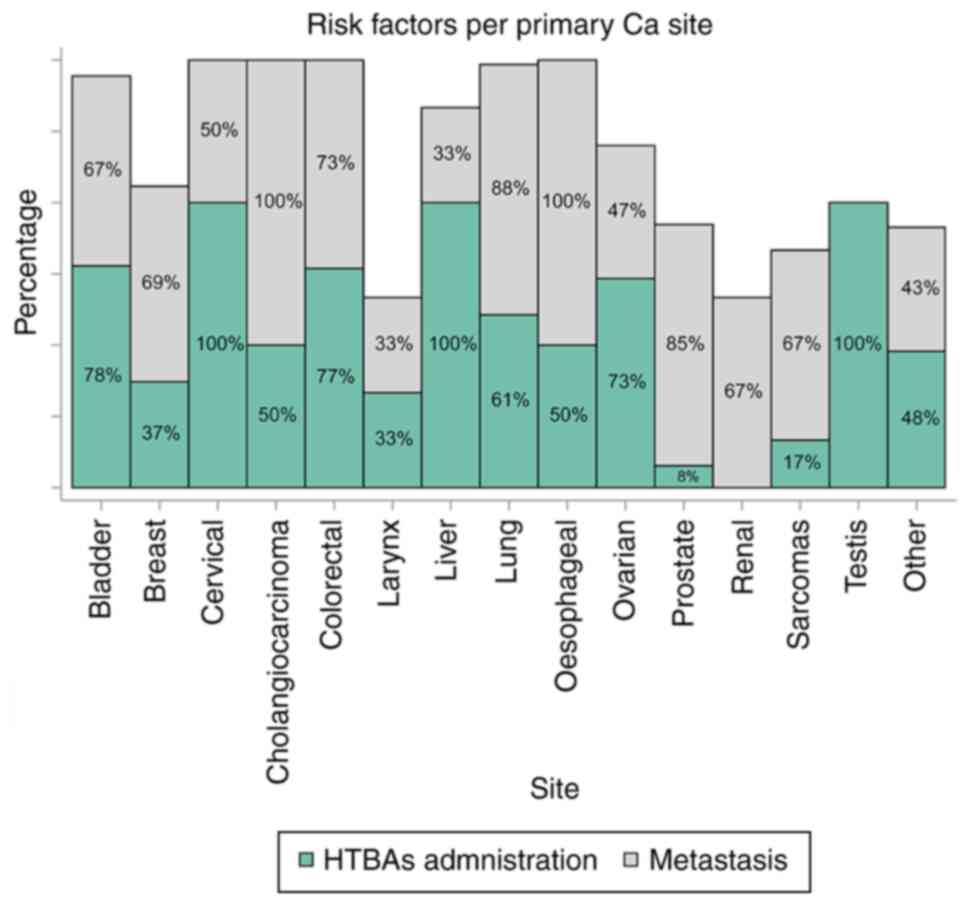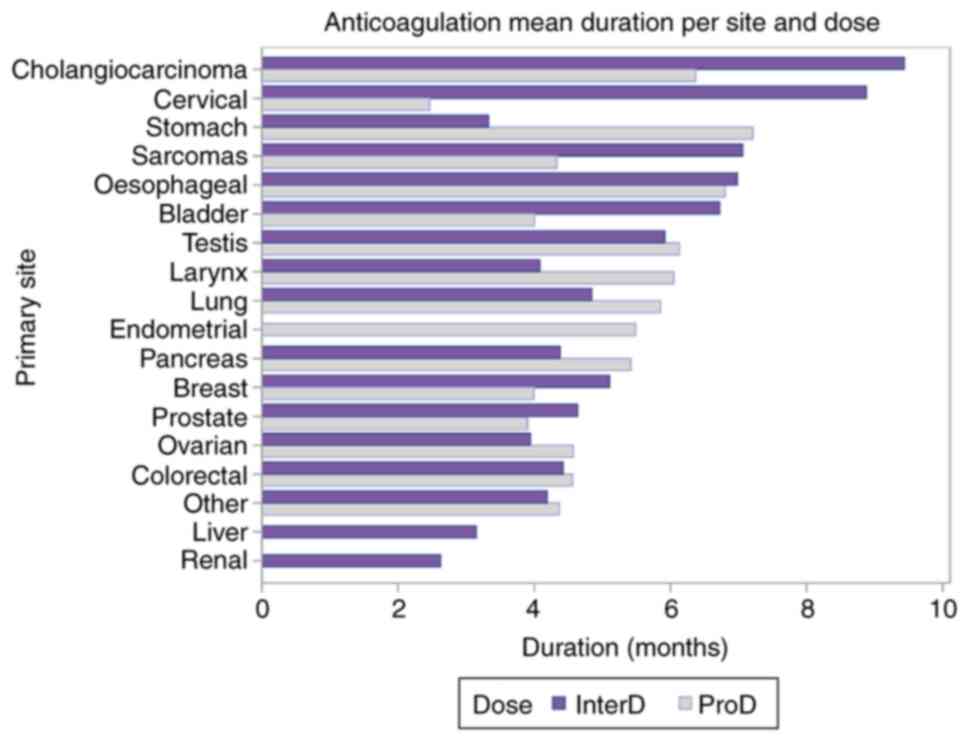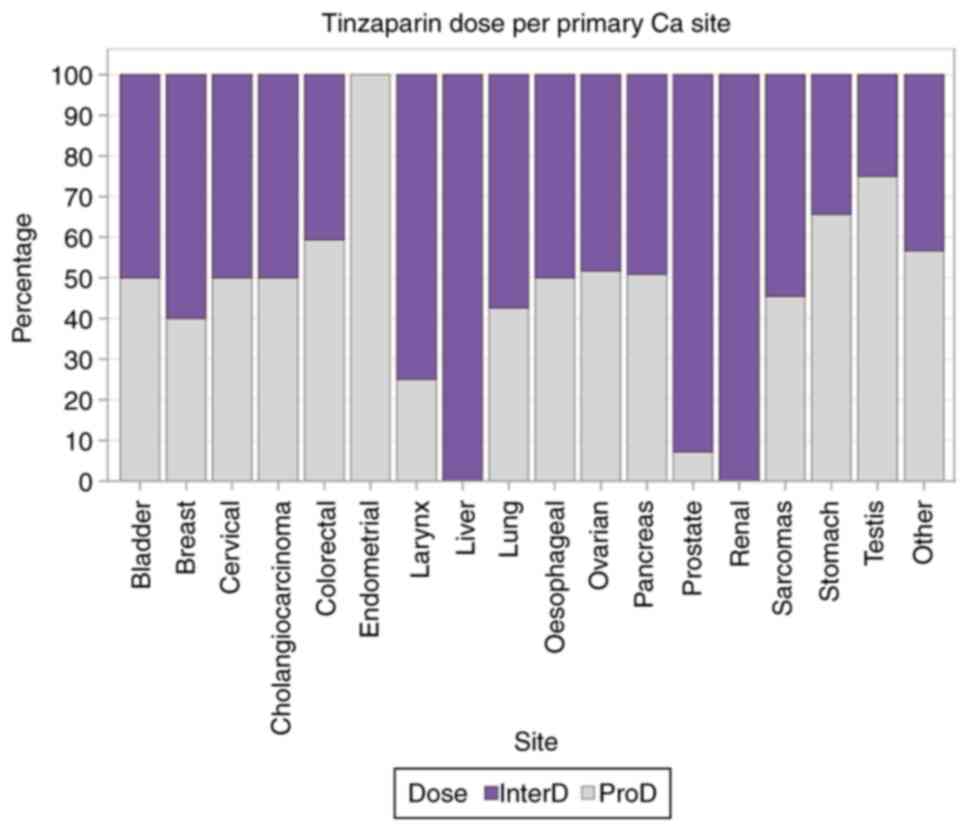|
1
|
Khorana AA, Francis CW, Culakova E,
Kuderer NM and Lyman GH: Thromboembolism is a leading cause of
death in cancer patients receiving outpatient chemotherapy. J
Thromb Haemost. 5:632–634. 2007. View Article : Google Scholar : PubMed/NCBI
|
|
2
|
National Institute for Health and Care
Exellence, . Venous thromboembolic diseases: diagnosis, management
and thrombophilia testing. https://www.nice.org.uk/guidance/ng158/resources/venous-thromboembolic-diseases-diagnosis-management-and-thrombophilia-testing-pdf-66141847001797November
10–2021
|
|
3
|
Badescu MC, Ciocoiu M, Badulescu OV,
Vladeanu MC, Bojan IB, Vlad CE and Rezus C: Prediction of bleeding
events using the VTE-BLEED risk score in patients with venous
thromboembolism receiving anticoagulant therapy (Review). Exp Ther
Med. 22:13442021. View Article : Google Scholar : PubMed/NCBI
|
|
4
|
Geerts WH, Pineo GF, Heit JA, Bergqvist D,
Lassen MR, Colwell CW and Ray JG: Prevention of venous
thromboembolism: The Seventh ACCP conference on antithrombotic and
thrombolytic therapy. Chest. 126 (Suppl 3):338S–400S. 2004.
View Article : Google Scholar : PubMed/NCBI
|
|
5
|
Ay C, Pabinger I and Cohen AT:
Cancer-associated venous thromboembolism: Burden, mechanisms, and
management. Thromb Haemost. 117:219–230. 2017. View Article : Google Scholar : PubMed/NCBI
|
|
6
|
National Cancer Institute (NIH), . Age and
cancer risk. NIH; Bethesda, MD: 2021, https://www.cancer.gov/about-cancer/causes-prevention/risk/ageMarch
5–2021
|
|
7
|
American Heart Association, . Risk factors
for venous thromboembolism (VTE). American Heart Association;
Dallas, TX: 2021 https://www.heart.org/en/health-topics/venous-thromboembolism/risk-factors-for-venous-thromboembolism-vteLast
Reviewed. March 30–2017
|
|
8
|
Khorana AA and Connolly GC: Assessing risk
of venous thromboembolism in the patient with cancer. J Clin Oncol.
27:4839–4847. 2009. View Article : Google Scholar : PubMed/NCBI
|
|
9
|
Iorga RA, Bratu OG, Marcu RD, Constantin
T, Mischianu DLD, Socea B, Gaman MA and Diaconu CC: Venous
thromboembolism in cancer patients: Still looking for answers. Exp
Ther Med. 18:5026–5032. 2019.PubMed/NCBI
|
|
10
|
Haddad TC and Greeno EW:
Chemotherapy-induced thrombosis. Thromb Res. 118:555–568. 2006.
View Article : Google Scholar : PubMed/NCBI
|
|
11
|
Blom JW, Osanto S and Rosendaal FR: The
risk of a venous thrombotic event in lung cancer patients: Higher
risk for adenocarcinoma than squamous cell carcinoma. J Thromb
Haemost. 2:1760–1765. 2004. View Article : Google Scholar : PubMed/NCBI
|
|
12
|
Khorana AA, Francis CW, Culakova E and
Lyman GH: Risk factors for chemotherapy-associated venous
thromboembolism in a prospective observational study. Cancer.
104:2822–2829. 2005. View Article : Google Scholar : PubMed/NCBI
|
|
13
|
Oppelt P, Betbadal A and Nayak L: Approach
to chemotherapy-associated thrombosis. Vasc Med. 20:153–161. 2015.
View Article : Google Scholar : PubMed/NCBI
|
|
14
|
Roopkumar J, Swaidani S, Kim AS, Thapa B,
Gervaso L, Hobbs BP, Wei W, Alban TJ, Funchain P, Kundu S, et al:
Increased incidence of venous thromboembolism with cancer
immunotherapy. Med (NY). 2:423–434. 2021.PubMed/NCBI
|
|
15
|
Roopkumar J, Kim AS, Bicky T, Hobbs BP and
Khorana AA: Venous thromboembolism in cancer patients receiving
immunotherapy. Blood. 132 (Suppl 1):S25102018. View Article : Google Scholar
|
|
16
|
Sorensen HT, Mellemkjaer L, Olsen JH and
Baron JA: Prognosis of cancers associated with venous
thromboembolism. N Engl J Med. 343:1846–1850. 2000. View Article : Google Scholar : PubMed/NCBI
|
|
17
|
Khorana AA, Dalal MR, Lin J and Connolly
GC: Health care costs associated with venous thromboembolism in
selected high-risk ambulatory patients with solid tumors undergoing
chemotherapy in the United States. Clinicoecon Outcomes Res.
5:101–108. 2013. View Article : Google Scholar : PubMed/NCBI
|
|
18
|
Tsoukalas N, Papakotoulas P, Christopoulou
A, Ardavanis A, Koumakis G, Papandreou C, Papatsimpas G, Papakostas
P, Samelis G, Andreadis C, et al: Real-world data on
thromboprophylaxis in active cancer patients: Where are we? Are we
getting there? Cancers (Basel). 12:19072020. View Article : Google Scholar : PubMed/NCBI
|
|
19
|
Estrada-Y-Martin RM and Oldham SA: CTPA as
the gold standard for the diagnosis of pulmonary embolism. Int J
Comput Assist Radiol Surg. 6:557–563. 2011. View Article : Google Scholar : PubMed/NCBI
|
|
20
|
Zierler BK: Ultrasonography and diagnosis
of venous thromboembolism. Circulation. 109((12 Suppl 1)): SI9–S14.
2004.PubMed/NCBI
|
|
21
|
Elyamany G, Alzahrani AM and Bukhary E:
Cancer-associated thrombosis: An overview. Clin Med Insights Oncol.
8:129–137. 2014. View Article : Google Scholar : PubMed/NCBI
|
|
22
|
Kaatz S, Ahmad D, Spyropoulos AC and
Schulman S; Subcommittee on Control of Anticoagulation, :
Definition of clinically relevant non-major bleeding in studies of
anticoagulants in atrial fibrillation and venous thromboembolic
disease in non-surgical patients: Communication from the SSC of the
ISTH. J Thromb Haemost. 13:2119–2126. 2015. View Article : Google Scholar : PubMed/NCBI
|
|
23
|
Schulman S and Kearon C; Subcommittee on
Control of Anticoagulation of the Scientific and Standardization
Committee of the International Society on Thrombosis and
Haemostasis, : Definition of major bleeding in clinical
investigations of antihemostatic medicinal products in non-surgical
patients. J Thromb Haemost. 3:692–694. 2005. View Article : Google Scholar : PubMed/NCBI
|
|
24
|
Key NS, Khorana AA, Kuderer NM, Bohlke K,
Lee AYY, Arcelus JI, Wong SL, Balaban EP, Flowers CR, Francis CW,
et al: Venous thromboembolism prophylaxis and treatment in patients
with cancer: ASCO clinical practice guideline update. J Clin Oncol.
38:496–520. 2020. View Article : Google Scholar : PubMed/NCBI
|
|
25
|
Heit JA, O'Fallon WM, Petterson TM, Lohse
CM, Silverstein MD, Mohr DN and Melton LJ III: Relative impact of
risk factors for deep vein thrombosis and pulmonary embolism: A
population-based study. Arch Intern Med. 162:1245–1248. 2002.
View Article : Google Scholar : PubMed/NCBI
|
|
26
|
Ohashi Y, Ikeda M, Kunitoh H, Sasako M,
Okusaka T, Mukai H, Fujiwara K, Nakamura M, Oba MS, Kimura T, et
al: Venous thromboembolism in cancer patients: Report of baseline
data from the multicentre, prospective Cancer-VTE registry. Jpn J
Clin Oncol. 50:1246–1253. 2020. View Article : Google Scholar : PubMed/NCBI
|
|
27
|
Gregson J, Kaptoge S, Bolton T, Pennells
L, Willeit P, Burgess S, Bell S, Sweeting M, Rimm EB, Kabrhel C, et
al: Cardiovascular risk factors associated with venous
thromboembolism. JAMA Cardiol. 4:163–173. 2019. View Article : Google Scholar : PubMed/NCBI
|
|
28
|
Agnelli G, George DJ, Kakkar AK, Fisher W,
Lassen MR, Mismetti P, Mouret P, Chaudhari U, Lawson F and Turpie
AG; SAVE-ONCO Investigators, : Semuloparin for thromboprophylaxis
in patients receiving chemotherapy for cancer. N Engl J Med.
366:601–609. 2012. View Article : Google Scholar : PubMed/NCBI
|
|
29
|
Agnelli G, Gussoni G, Bianchini C, Verso
M, Mandalà M, Cavanna L, Barni S, Labianca R, Buzzi F, Scambia G,
et al: Nadroparin for the prevention of thromboembolic events in
ambulatory patients with metastatic or locally advanced solid
cancer receiving chemotherapy: A randomised, placebo-controlled,
double-blind study. Lancet Oncol. 10:943–949. 2009. View Article : Google Scholar : PubMed/NCBI
|
|
30
|
Carrier M, Abou-Nassar K, Mallick R,
Tagalakis V, Shivakumar S, Schattner A, Kuruvilla P, Hill D,
Spadafora S, Marquis K, et al: Apixaban to prevent venous
thromboembolism in patients with cancer. N Engl J Med. 380:711–719.
2019. View Article : Google Scholar : PubMed/NCBI
|
|
31
|
Khorana AA, Soff GA, Kakkar AK, Vadhan-Raj
S, Riess H, Wun T, Streiff MB, Garcia DA, Liebman HA, Belani CP, et
al: Rivaroxaban for thromboprophylaxis in high-risk ambulatory
patients with cancer. N Engl J Med. 380:720–728. 2019. View Article : Google Scholar : PubMed/NCBI
|
|
32
|
Burlacu A, Genovesi S, Goldsmith D,
Rossignol P, Ortiz A, Kalra PA, Małyszko J, Banach M, Kanbay M and
Covic A: Bleeding in advanced CKD patients on antithrombotic
medication-a critical appraisal. Pharmacol Res. 129:535–543. 2018.
View Article : Google Scholar : PubMed/NCBI
|
|
33
|
Johansen KB and Balchen T: Tinzaparin and
other low-molecular-weight heparins: What is the evidence for
differential dependence on renal clearance? Exp Hematol Oncol.
2:212013. View Article : Google Scholar : PubMed/NCBI
|
|
34
|
Atiq F, van den Bemt PM, Leebeek FW, van
Gelder T and Versmissen J: A systematic review on the accumulation
of prophylactic dosages of low-molecular-weight heparins (LMWHs) in
patients with renal insufficiency. Eur J Clin Pharmacol.
71:921–929. 2015. View Article : Google Scholar : PubMed/NCBI
|
|
35
|
Siguret V, Pautas E, Février M, Wipff C,
Durand-Gasselin B, Laurent M, Andreux JP, d'Urso M and Gaussem P:
Elderly patients treated with tinzaparin (Innohep) administered
once daily (175 anti-Xa IU/kg): Anti-Xa and anti-IIa activities
over 10 days. Thromb Haemost. 84:800–804. 2000. View Article : Google Scholar : PubMed/NCBI
|
|
36
|
Wu C and Lee AY: Novel or non-vitamin K
antagonist oral anticoagulants and the treatment of
cancer-associated thrombosis. Semin Thromb Hemost. 41:237–243.
2015. View Article : Google Scholar : PubMed/NCBI
|
|
37
|
Short NJ and Connors JM: New oral
anticoagulants and the cancer patient. Oncologist. 19:82–93. 2014.
View Article : Google Scholar : PubMed/NCBI
|
|
38
|
Johnstone C and Rich SE: Bleeding in
cancer patients and its treatment: A review. Ann Palliat Med.
7:265–273. 2018. View Article : Google Scholar : PubMed/NCBI
|
|
39
|
Patsopoulos NA: A pragmatic view on
pragmatic trials. Dialogues Clin Neurosci. 13:217–224. 2011.
View Article : Google Scholar : PubMed/NCBI
|















